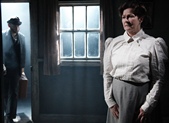SITE GUIDE
SEARCH
REVIEWS
REVIEW ARCHIVES
ADVERTISING AT CURTAINUP
FEATURES
NEWS
Etcetera and
Short Term Listings
LISTINGS
Broadway
Off-Broadway
NYC Restaurants
BOOKS and CDs
OTHER PLACES
Berkshires
London
California
New Jersey
DC
Connecticut
Philadelphia
Elsewhere
QUOTES
TKTS
PLAYWRIGHTS' ALBUMS
LETTERS TO EDITOR
FILM
LINKS
MISCELLANEOUS
Free Updates
Masthead
Writing for Us
A CurtainUp  London Review
London Review
 London Review
London ReviewMixed Marriage
|
It is more important for a woman to make a good dinner for a man than to appear in the same church.
— Mrs Rainey
|

Christopher Brandon as Hugh and Fiona Victory as Mrs Rainey (Photo: Francis Loney) |
St John Ervine is a predecessor of Sean O’Casey and the great tradition of twentieth century Irish political plays. The programme tells us that this playwright is the man of whom the Irish Times said, "Mr Ervine proves to us that prejudice is stronger than reason."
Mixed Marriage is about a strike by Belfast dockyard workers in 1907 and the Rainey family central to the play are Protestants. All the action takes place downstairs in the Rainey’s homely kitchen and living room.
The head of the family, John Rainey (Daragh O’Malley) is an inspirational and rousing speaker on behalf of the strikers. Michael O’Hara (Damien Hannaway) is a Catholic activist and family friend and the two men, despite their religious differences, agree to work together to unite the religious factions into a solid strike movement.
The fly in the ointment for Mr Rainey is the woman his son Hugh (Christopher Brandon) wants to marry, a Catholic girl Nora Murray (Nora-Jane Noone). Although Mr Rainey has no objection to joining together with Catholic strikers, he draws the line when it comes to his son wanting a marital union with one of the "Papists". Mrs Rainey his wife (Fiona Victory) is caught in the middle, trying to reason with her husband when he threatens to throw their son Hugh out of the family home. Before the family can sort out their problems, the strike comes to a head and an ugly situation develops with soldiers called and a riot starts.
On the Rainey’s wall is a reproduction of the painting on horseback of the bewigged Protestant victor of the Battle of the Boyne in 1690, William of Orange, King William III of England, Scotland and Ireland. William defeated his father in law, the Catholic leaning King James II who fled to France. This is the 17th Century mythology of Protestants versus Catholics which fuelled the Northern Irish conflict versus the Fenians and Irish Nationalism throughout the twentieth century.
Daragh O’Malley is the stocky and emphatically doughty father of the house whose wife stands up to his religious bigotry. As Mrs Rainey shouts at her husband, he whimpers, "She took my son from me." I was so involved by the convincing acting of what is really melodrama that I gasped out loud at one point. Nora-Jane Noone plays the sweet girl, risking the censure of both families and Christopher Brandon is uprightly sticking by his choice of bride. I liked too Damien Hannaway’s brave Catholic activist, the voice of moderation and co-operation heard too little.
Sam Yates directs. The riot scene is exciting but conducted behind the shuttered windows as shouts are heard in the street and the soldiers threaten to shoot to quell the crowds. Considering this scene is entirely narrated with sound effects it is gripping theatre.
A note about the word "quare" which is liberally used by everyone in this play. It is an Irish localised version of the word queer and means real or quite or extremely and is used as an adverb alongside another adjective for emphasis rather than any specific meaning.
Pairing with this production of Mixed Marriage, at the Finborough on Sundays and Mondays is Drama at Inish also known as Is Life Worth Living, a play written by Lennox Robinson in1933. He was the first director of Mixed Marriage at the Abbey Theatre in Dublin. Ervine and Robinson are contemporaries of WB Yeats, Lady Gregory, and JM Synge, whose play The Playboy of the Western World is currently showing at the Old Vic.
For Elyse Sommer’s review of another of St John Ervine’s plays in New York go here.
|
Subscribe to our FREE email updates with a note from editor Elyse Sommer about additions to the website -- with main page hot links to the latest features posted at our numerous locations. To subscribe,
E-mail: esommer@curtainup.comesommer@curtainup.com
put SUBSCRIBE CURTAINUP EMAIL UPDATE in the subject line and your full name and email address in the body of the message -- if you can spare a minute, tell us how you came to CurtainUp and from what part of the country. |
| Mixed Marriage
By St John Ervine Directed by Sam Yates Starring: Christopher Brandon, Damien Hannaway, Nora-Jane Noone, Daragh O’Malley, Joel Ormsby, Fiona Victory Designed by Richard Kent Lighting: David Plater Music and Sound: Alex Baranowski Running time: One hour 20 minutes without an interval Box Office: 0844 847 1652 Booking to 29th October 2011 Reviewed by Lizzie Loveridge based on 7th October 2011 performance at The Finborough Theatre, 118 Finborough Road, London SW10 9ED (Tube: Earls Court) |
|
REVIEW FEEDBACK Highlight one of the responses below and click "copy" or"CTRL+C"
Paste the highlighted text into the subject line (CTRL+ V): Feel free to add detailed comments in the body of the email . . . also the names and emails of any friends to whom you'd like us to forward a copy of this review. |




